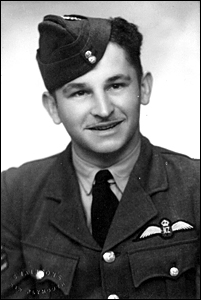BRIAN LEONARD BUTLER is the son of
JOSEPH SILVAN BUTLER & MARY MARGARET BUTLER nee FABISH
 42992: Pilot Officer Brian Leonard BUTLER was born on the18 December 1923 in New Plymouth, and was educated at the Huirangi Primary School, Waitara. His sporting activities included fishing, hunting, riding, swimming and, whilst at school, rugby football, where he also gained his Proficiency Certificate. After leaving school his occupation was as a farmer for five years, being employed for this period on his father's farm at Waitara. He then received further educational instruction under the Air Training Corps Correspondence Scheme before making an application to enlist into aircrew training in the RNZAF in May 1942.
42992: Pilot Officer Brian Leonard BUTLER was born on the18 December 1923 in New Plymouth, and was educated at the Huirangi Primary School, Waitara. His sporting activities included fishing, hunting, riding, swimming and, whilst at school, rugby football, where he also gained his Proficiency Certificate. After leaving school his occupation was as a farmer for five years, being employed for this period on his father's farm at Waitara. He then received further educational instruction under the Air Training Corps Correspondence Scheme before making an application to enlist into aircrew training in the RNZAF in May 1942.
P/O BUTLER enlisted with the RNZAF at Seagrove on 16 August 1942 and the following February was posted to Rotorua where he received his initial training. After satisfactorily completing this course he was on 4 April 1942 posted to No. 2 Elementary Flying Training School, Ashburton to commence his flying training, in continuation of which he was on 31 May posted to No. 1 Service Flying Training School, Wigram. Whilst training at this school he was on 2 August awarded the flying badge and on 25 September promoted to the rank of Sergeant. He was promoted again this time to Flight Sergeant on 25 March 1944 and on 5 February 1945 was commissioned in the rank of Pilot Officer.
Sailing for the United Kingdom in October 1943 P/O Butler, on arrival was posted to No. 24 Elementary Flying Training School, Sealand, near Chester, for a short period of flying training. He was then posted to the Empire Flying School, Hullavington, Wiltshire, from which he proceeded to No. 20 Advanced Flying Unit, Weston-on-the-Green, a satellite for Kidlington, Oxfordshire. From this unit he was posted to No. 10 Operational Training Unit, Stanton Harcourt, a satellite for Abingdon, Oxfordshire, where he commenced his operation training, flying Whitley bomber aircraft.
Having completed this training he proceeded in October to No. 1658 Conversion Unit, Riccall, Yorkshire, where he converted to Halifax bomber aircraft. On 6 December 1944 he was posted to No. 192 Squadron, Foulsham, Norfolk and from this base carried out 12 operational raids over Germany and Holland. Listed among the targets he attacked are: Ulm, Mainz, Gelsenkirchen, Antwerp, Mannheim, Scholven and Bonn. He also attacked targets on the Dutch coast.
P/O BUTLER was captain of a Halifax bomber aircraft which was detailed to accompany a bomber attack on an oil refinery at Politz, near Stettin, Germany, on the night of the 8/9 February 1945. After taking off from Foulsham nothing was heard of P/O BUTLER, his crew, or the aircraft, until a Lancaster bomber, which was also on the attack, reported having had a collision with a Halifax in a cloud shortly after leaving the Danish coast on the way home. Portions of the Halifax were subsequently found on the Lancaster and were identified as being parts of the one in which P/O BUTLER and his crew were flying. It was officially assumed therefore that P/O Butler, with all the members of his crew, crashed in the North Sea. P/O BUTLER, together with the members of his crew, were reported missing and subsequently officially presumed dead, He died on the 9 February 1945, aged 21 years.
The purpose of all ops was to carry out some sort of Radio Counter Measures RCM's work. Bombs were carried and dropped on the Main Force targets.
192 Squadron were one of several units equipped for RCM's. These aircraft did not operate as part of the main force of bombers, but carried sophisticated jamming equipment designed to confuse the enemy ground-to-air and air-to-air radar, as well as generally trying to screw up radio telephony between radar-controlled night fighters and their ground stations.
The Luftwaffe were very efficient in their communications techniques and could readily detect RAF aircraft almost over their own bases, so it was important to provide airborne jamming and screening ahead and during a raid. As night fighters have a limited range, if they could be decoyed, it took pressure off the Main Force. Brians 192 Squadron were the decoys and his RCM aircraft attracted the attention, but apparently they were extremely successful at it.
The main techniques used were:
ABC (Air Borne Cigar) listening to as well as jamming ground-to-air voice transmissions
Mandrel: detecting and jamming ground-to-air enemy fighter control radar
Gaston/Tinsel: jamming ground radar stations' voice transmissions
Carpet: jamming radar controlled flak
Peter/Sunshine: developing bogus alerts on enemy radar, to confuse the enemy on the numbers of aircraft being detected
Window: dropping aluminium strips to blind ground radar. Often the RCM crews were briefed to fly extremely close to the enemy coast, *to do their thing* then making a hasty retreat, returning after a while to keep the enemy guessing.